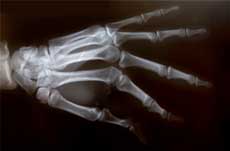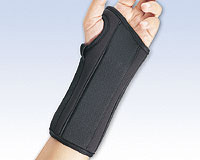
Skiing Wrist Fracture Injury

What is a Wrist Fracture Injury?
Snowboarding is such a dangerous sport. Beginners are often faced with a higher risk for unfriendly falls that could, at the very least, give them a Wrist Fracture injury. When a snowboarder falls during an adventure in the snow, he is most likely to stretch out a hand to break it. As a result, Scaphoid and Colles fractures occur. Those account to around 100,000 wrist fractures recorded among snowboarders every year.
Scaphoid and Colles fracture
The Scaphoid is one of the eight small bones called Carpal that make up the wrist. An injury in this bone might not result to a swollen wrist but it will definitely hurt. By falling on an outstretched hand, you are exposing your Scaphoid to possible damage.
The Colles, on the other hand, is a radius bone that is found right above the wrist. Feeling an unbearable pain on the wrist and the hand is a sure sign that your have fractured the Colles. Other signs and symptoms include a ‘dinner fork” deformity and wrist swelling.
Any suspicion of a wrist fracture injury should take a patient immediately to the nearest hospital or in the accident and emergency department. The doctor should know exactly what to do with it.
Aside from swelling and intolerable pain, a Wrist Fracture injury is also characterized by tenderness at the junction of the thumb and wrist.
Rehabilitation of an injured wrist usually starts with a range of exercises concentrated on the shoulders, the fingers, the thumbs, and the side of the broken wrist that is plastered. This way, stiffness is prevented and mobility is maintained. Once the plaster is removed, the use of therapeutic equipments will help greatly in relieve swelling and bringing back the strength of the wrist. Wrist support and a thumb spica must also be worn at times when not doing exercises after the plaster is removed. They will provide the protection and support your wrist needs to get back in shape.
What can you do to prevent a Wrist Fracture?
Wrist support ably helps lessen the risk of snowboarders to Wrist Fracture injuries. A reliable wrist guard should help you prevent fracturing anything during a fall. They are widely available in most skiing and snowboarding shops worldwide so you do not have any reason not to get one for your own protection.
What should you do if you suffer a Wrist Fracture Injury?
A mild Wrist Fracture usually takes six weeks to heal. That is, if the condition is diagnosed immediately. After a bad fall, submit yourself to an examination so your doctor would know what treatment to prescribe. An X-ray should show a good enough picture of the injury.
If the fragments of broken bones are close together but needs to be aligned, putting the forearm and the wrist under a plaster is usually enough to resolve the problem. Hand therapy balls and putty are used in the rehabilitation period to put the wrist back in its fighting form.
What about wrist fractures under the guards?
Wearing wrist guards lessen, but not completely eliminate, a snowboarder’s risk to Wrist Fracture injuries. Sometimes the force is simply too much for a wrist protection system to battle. There are some cases as well where the severity of the fracture is brought about by the wrist guard itself. The Medicins de Montagne group of doctors in the French Alps reported at the last ISSS meeting in 2005 that some snowboarders wearing rigid guards still sustained wrist fractures after a fall. This is not to say that wrist guards are useless. It is still much safer to go snowboarding with them on. It only means that you must be careful in choosing the product you will use. Even when you are fully guarded with wrist support, take an extra ounce of care to ensure that you are not causing damage to any of your bones during your snowboarding adventure.
Learning to fall properly
There is a big difference between a good and bad fall. If you know how to fall the proper way, you are obviously decreasing your risk to Limb and Wrist injuries. Simulating a parachute fall is one of the most effective techniques that snowboarding instructors advise. Tucking the forearms towards the chest with the fists clenched could save you from fractures by letting your buttocks take the impact.
Recommended Product

Click here to view the Pro lite wrist support for skiing wrist fractures

















